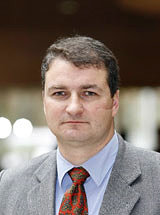Prof. Reinhard Kienberger is elected as a member of the European Academy of Sciences and Arts
The Austrian physicist is honoured for his pioneering contributions to the field of attosecond physics.
 Reinhard Kienberger, professor of experimental physics at the Technische Universität München (TUM) and research group leader in the Laboratory for Attosecond Physics at the Max Planck Institute of Quantum Optics in Garching has made pioneering contributions to the field of attosecond physics. With the election as an ordinary member of the European Academy of Sciences and Arts (Salzburg, Austria) he belongs to a circle of scholars who work on issues most relevant to Europe. Among the roughly 1500 members of the academy there are 29 Nobel prize winners.
Reinhard Kienberger, professor of experimental physics at the Technische Universität München (TUM) and research group leader in the Laboratory for Attosecond Physics at the Max Planck Institute of Quantum Optics in Garching has made pioneering contributions to the field of attosecond physics. With the election as an ordinary member of the European Academy of Sciences and Arts (Salzburg, Austria) he belongs to a circle of scholars who work on issues most relevant to Europe. Among the roughly 1500 members of the academy there are 29 Nobel prize winners.
Dr. Reinhard Kienberger comes from Saalfelden in Austria. In 2002 he got his doctoral degree in the group of Prof. Ferenc Krausz, then at the Technical University of Vienna, on the subject “Subfemtosecond XUV Pulse Generation and Measurement”. There he was the first ever to produce light pulses shorter than one femtosecond (a millionth of a billionth of a second). In 2004 he received the APART grant (Austrian Programme for Advanced Research and Technology) of the Austrian Academy of Sciences, which enabled him to spend 10 months at the Stanford Linear Accelerator Center (USA) in the same year. During this time he showed for the first time that techniques for characterizing laser-generated X-rays could be extended to femtosecond X-rays produced by an accelerator.
On his return from the USA in 2005 he became a research scientist in the “Attosecond Division” of Prof. Ferenc Krausz at the MPQ. In 2006 he received the Sofja Kowalevskaja Prize by the Alexander von Humboldt Foundation and set up the independent Max Planck research group “Attosecond Dynamics”. In 2007 he received the “Starting Grant” of the European Research Council, and in September 2009 he became appointed professor at the Technische Universität München. In November 2010 he was presented with the prestigious ICO Prize of the International Commission for Optics.
One of the main goals of attosecond physics is to capture snapshots of the inner life of atoms. By this scientists expect to gain insights into the actual course of chemical reactions, the behaviour of electrons in solid materials, and the interaction between light and matter. New discoveries made through this approach could find application in chemistry, molecular biology, nanotechnology, and treatment of tumours. Olivia Meyer-Streng
Contact:
Prof. Dr. Reinhard Kienberger
Technische Universität München
James-Franck-Straße
Physik-Department 2
Phone: 49 (0) 89 / 289 - 12837
E-mail: reinhard.kienberger@tum.de
Dr. Olivia Meyer-Streng
Press & Public Relations
Max Planck Institute of Quantum Optics
Hans-Kopfermann-Str. 1
D-85748 Garching
Phone: +49 (0) 89 / 32905 - 213
E-mail: olivia.meyer-streng@mpq.mpg.de